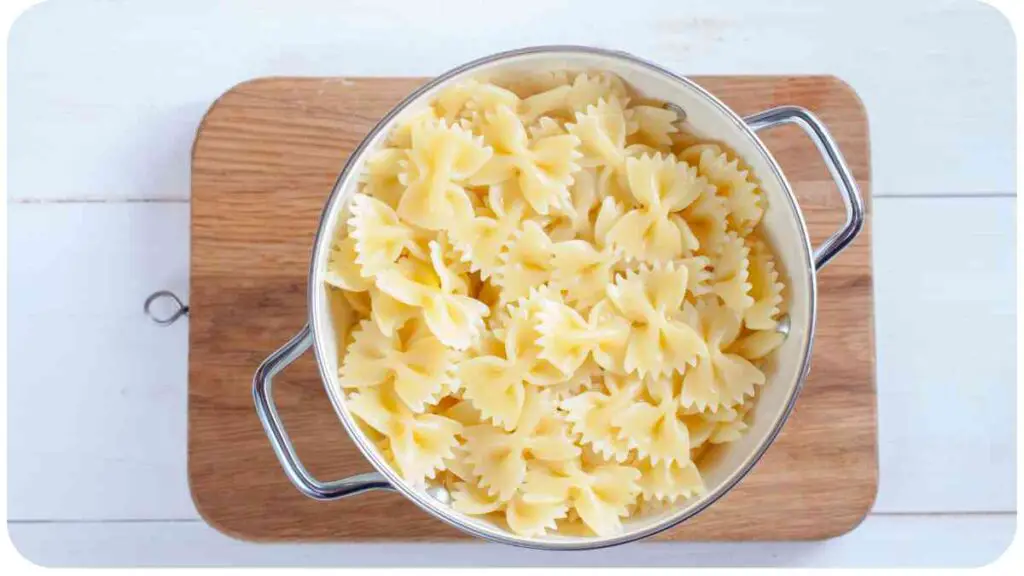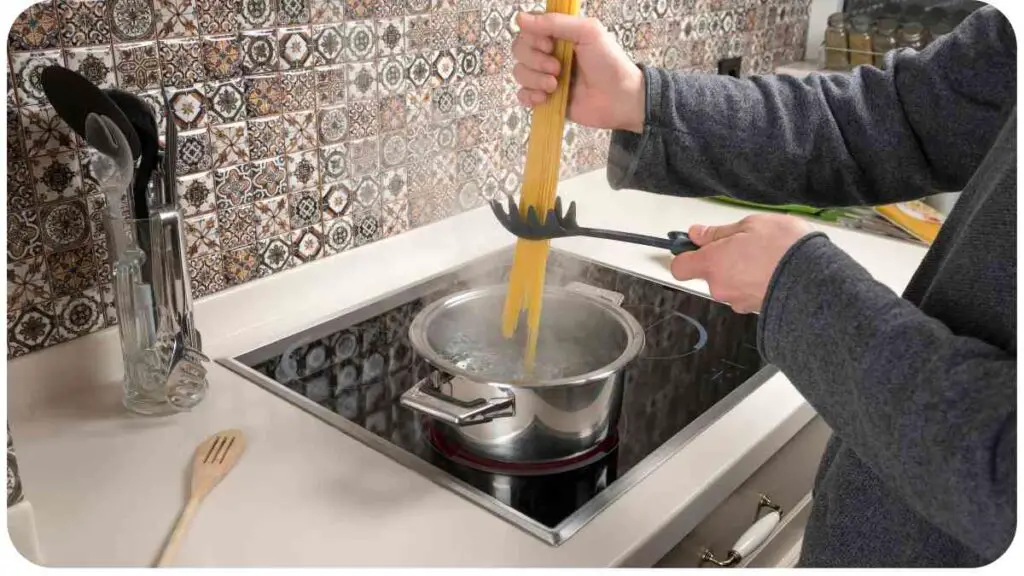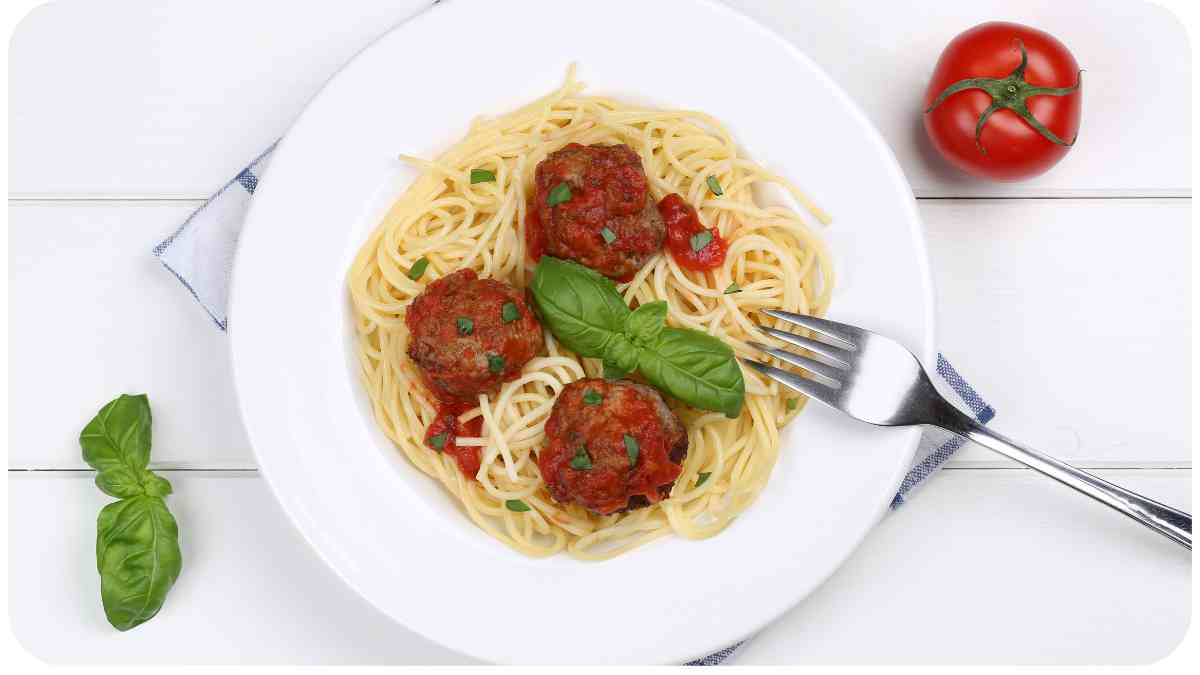When it comes to cooking pasta, there’s nothing more disappointing than ending up with a sticky, clumpy mess. Pasta sticking together can turn a perfectly good meal into a culinary disaster.
But fear not! By understanding the factors that cause pasta to stick and implementing some simple tips and tricks, you can prevent this frustrating issue and serve delicious, perfectly cooked pasta every time.
| Takeaways |
|---|
| Use sufficient salt in the boiling water to prevent sticking |
| Stir the pasta frequently during cooking to separate the strands |
| Choose pasta shapes with ridges or grooves to reduce sticking |
| Avoid rinsing cooked pasta to retain starch for sauce adherence |
| Toss freshly cooked pasta with sauce immediately to prevent clumping |
| Store leftover pasta properly by tossing with a bit of olive oil |
2. Choosing the Right Pasta
Before we dive into the various methods to prevent pasta from sticking together, it’s essential to choose the right type of pasta for your dish. Different pasta shapes have different cooking times and textures. Consider the sauce or seasoning you plan to use, as certain sauces adhere better to specific pasta shapes.
For example, long, thin pasta like spaghetti works well with smooth, slippery sauces, while shorter, textured shapes like penne or fusilli are great for capturing chunkier sauces.
For the “The Art of Fermentation” enthusiasts, learn how to create your own vibrant and tangy Kimchi and Kombucha at home with this comprehensive fermentation guide. Discover the secrets of preserving flavors naturally.
3. Cooking Pasta: The Fundamental Steps

To achieve perfectly cooked pasta with ideal texture and taste, it is crucial to follow the fundamental steps of cooking pasta. These steps should be the backbone of your pasta-making process, and any variations or modifications will be built upon this foundation. Here are the basic steps:
Step 1: Boil Sufficient Water: Use a large pot and fill it with enough water to allow the pasta room to cook and move freely.
Step 2: Salt the Water: Add salt to the boiling water to season the pasta as it cooks. This step is vital for enhancing the overall flavor of the dish.
TABLE 1: Recommended Pasta-to-Water Ratio
| Pasta Type | Water Amount |
| Long and Thin | 1 liter per 100g |
| Short and Small | 2 liters per 100g |
| Filled Pasta | 3 liters per 100g |
Step 3: Add the Pasta: Gently add the pasta to the boiling water, making sure it is fully submerged. Stir immediately to prevent sticking.
Step 4: Cook Al Dente: Check the cooking time indicated on the package and aim to cook the pasta al dente, which means it has a slight firmness when bitten. This preserves the pasta’s texture and prevents it from becoming overly soft and sticky.
Tip 1: Salt the Boiling Water
Adding salt to the boiling water not only enhances the pasta’s flavor but also helps to prevent it from sticking. The salt interacts with the pasta, reducing surface stickiness and creating a barrier that prevents the strands from clumping together. Remember to use enough salt to adequately season the pasta, but not so much that it becomes overly salty.
Tip 2: Stir Frequently
Once you’ve added the pasta to the boiling water, don’t just leave it unattended. Stir the pasta frequently, especially during the first few minutes of cooking. This will help to separate the strands and prevent them from sticking together. A gentle stir every couple of minutes should do the trick.
Wondering “Why Is Your Bread Not Rising?” during baking? Find answers and troubleshooting tips in this helpful bread-making resource. Perfect your bread and pasta recipes.
TABLE 2: Cooking Times for Popular Pasta Shapes
| Pasta Type | Cooking Time |
| Spaghetti | 9-12 minutes |
| Penne | 10-12 minutes |
| Fusilli | 8-10 minutes |
| Linguine | 11-13 minutes |
Tip 3: Use Sufficient Water
Using an ample amount of boiling water is crucial for preventing pasta from sticking. When the pasta is crowded in too little water, it can release more starch, causing it to become sticky. Make sure the pot you use is large enough to hold the pasta comfortably, and use the recommended water-to-pasta ratio based on the type of pasta you are cooking (refer to Table 1).
Tip 4: Add Oil to the Water (Debatable)
Some people suggest adding a drizzle of oil to the boiling water to prevent pasta from sticking. While this method can create a slick coating on the pasta, it may also make it more challenging for sauce to adhere to the cooked pasta later on. It’s a matter of personal preference, so feel free to experiment and see what works best for you.
Tip 5: Avoid Rinsing Cooked Pasta
After cooking your pasta, resist the temptation to rinse it under cold water. Rinsing removes the starch that helps the sauce cling to the pasta, resulting in a dish with less flavor and diminished texture. Instead, drain the pasta immediately and proceed to the next step: tossing it with sauce.
TABLE 3: Recommended Sauces for Different Pasta Shapes
| Pasta Type | Recommended Sauces |
| Spaghetti | Tomato-based sauces, carbonara |
| Penne | Pesto, marinara, Alfredo |
| Fusilli | Creamy sauces, bolognese |
| Linguine | Seafood, oil-based sauces |
Tip 6: Toss with Sauce Immediately
To prevent sticky pasta, it’s essential to toss the cooked pasta with the sauce immediately after draining. The residual heat from the pasta will allow the sauce to penetrate and coat each strand, ensuring even distribution and minimizing the chance of clumping. This step is crucial, especially when using thick or chunky sauces.
Tip 7: Optimize Cooking Time
Overcooking pasta can lead to a sticky, mushy result. It’s important to follow the cooking time instructions on the package and check the pasta a minute or two before the suggested time. Taste a strand to ensure it is cooked al dente, with a slight resistance to the bite. Remember, the pasta will continue to cook slightly after being tossed with sauce, so slightly undercooking it is preferable.
Tip 8: Know Your Pasta Types
Different pasta shapes have different cooking times and characteristics, which can affect their likelihood of sticking together. Familiarize yourself with the specific cooking times and idiosyncrasies of your favorite pasta shapes. Understanding these nuances will help you achieve better results and build confidence in creating perfectly cooked pasta.
Ensuring kitchen safety is paramount. Explore “How to Prevent Your Cutting Board from Slipping” with these essential safety tips to maintain a secure cooking environment.
TABLE 4: Cooking Times for Fresh Homemade Pasta
| Pasta Type | Cooking Time |
| Tagliatelle | 2-3 minutes |
| Ravioli | 3-5 minutes |
| Gnocchi | 2-3 minutes |
| Lasagna Sheets | 10-12 minutes |
Tip 9: Store Cooked Pasta Properly
If you find yourself with leftover pasta, it’s important to store it properly to prevent it from sticking together. Toss the cooked pasta with a small amount of olive oil to prevent clumping, and then transfer it to an airtight container or resealable plastic bag. Store the pasta in the refrigerator for up to three days, and when ready to eat, reheat it in a pan with a little bit of your desired sauce, ensuring it remains flavorful and non-sticky.
Save time and effort in your kitchen with the “Using Your Stand Mixer” guide. Uncover tips and techniques for efficient cooking with your stand mixer.
5. Troubleshooting: How to Deal with Sticky Pasta

Even with all the preventive measures in place, sometimes pasta still sticks together. Here are some common
Issue 1: Overcooking the Pasta
Overcooking the pasta can cause it to become mushy and sticky. To avoid this issue, follow the cooking time guidelines on the package and carefully monitor the pasta as it cooks. Test the pasta a minute or two before the suggested cooking time to check if it has reached the desired al dente texture.
Issue 2: Not Using Enough Water
Insufficient water in the pot can lead to sticky pasta. Make sure to use enough boiling water to allow the pasta to move freely and prevent it from sticking together. Refer to Table 1 for the recommended pasta-to-water ratio based on different types of pasta.
Issue 3: Insufficient Stirring
Failure to stir the pasta frequently during cooking can result in clumping. Stirring prevents the pasta from sticking together as it softens and cooks. Set a timer to remind yourself to stir the pasta every couple of minutes, ensuring that the strands stay separated.
Issue 4: Using the Wrong Pasta Shape
Certain pasta shapes are more prone to sticking together than others. The texture and surface area of the pasta play a role in how well it releases starch and retains sauce. If you often experience sticking issues, consider opting for pasta shapes with ridges or grooves that can hold sauce better, such as fusilli or penne.
6. Expert Tips from a Professional Pasta Maker
As someone who has been crafting pasta professionally for years, I’ve learned a few tricks of the trade that can help you avoid sticky pasta situations. Here are a few additional insights:
- Experiment with Homemade Pasta: If you have the time and inclination, try making your own pasta from scratch. Fresh homemade pasta, when cooked correctly, has a unique texture that is less likely to stick together. Explore different recipes and techniques to elevate your pasta game.
- Treat Yourself to Artisanal Pasta: If you’re not up for making your own pasta, consider trying artisanal or specialty brands that offer high-quality pasta. These varieties often have a rougher texture, allowing sauces to cling better and minimizing the chances of sticking.
- Use Pasta Cooking Water: When draining the pasta, it’s a good idea to reserve some of the cooking water. Adding a splash of this starchy water to the sauce can help create a silky, cohesive coating that adheres well to the pasta, reducing the risk of sticking.
- Experiment with Different Sauces: Don’t be afraid to experiment with various sauces to pair with your pasta. Some sauces, like carbonara or aglio e olio, rely on the stickiness of pasta to adhere and create flavor. By expanding your sauce repertoire, you can embrace sticky pasta in a delicious way.
- Embrace Imperfection: Remember that cooking pasta is both an art and a science. Even with the best techniques, occasional sticking may still happen. Embrace the imperfections and see them as an opportunity to learn and improve your skills in the kitchen.
“Is Your Microwave Heating Unevenly?” Troubleshoot and optimize your microwave’s performance using this guide. Discover how to ensure even heating in your microwave oven with practical advice for microwave users.
7. Conclusion
Preventing your pasta from sticking together is a combination of using the right techniques, choosing the appropriate pasta shape, and understanding the science behind it all.
By following the tips outlined in this guide and incorporating your own personal expertise and experiences, you can ensure that your pasta is always cooked to perfection, with each strand separate and truly irresistible.
So next time you prepare pasta, keep these tips in mind, and enjoy a delicious, non-sticky meal that will impress your family and friends. Happy cooking!
Further Reading
Here are some additional resources that provide more tips and guidance on preventing pasta from sticking together:
- Insider: How to Keep Pasta Noodles from Sticking Together: This article offers practical advice and techniques to prevent pasta from sticking, including tips on using oil, stirring, and handling cooked pasta.
- Uno Casa: How to Keep Pasta from Sticking: Uno Casa provides helpful tips for preventing pasta from sticking, such as using enough water, salting the water, and draining pasta properly. The article also includes suggestions for storing cooked pasta.
- Wiggly Wisdom: How to Stop Pasta Sticking Together When Cold: This post covers strategies to prevent pasta from sticking together when serving it cold, such as rinsing with cold water, using oil, and incorporating pasta sauce.
FAQs
Here are some frequently asked questions about preventing pasta from sticking together:
How can I prevent pasta from sticking together while cooking?
- Salting the boiling water and stirring the pasta frequently help minimize sticking by reducing the surface starch and separating the strands.
Should I add oil to the boiling water to prevent sticking?
- Adding oil is debatable. While it may help create a slick coating, it can also hinder sauce adhesion. It’s best to experiment and see what works for you.
Can I rinse cooked pasta to prevent sticking?
- It’s generally not recommended to rinse cooked pasta, as it removes starch that helps the sauce cling to the pasta. However, rinsing can be done if you’re serving the pasta cold.
How do I store leftover cooked pasta to prevent sticking?
- Toss the cooked pasta with a small amount of olive oil to prevent clumping, and store it in an airtight container in the refrigerator for up to three days.
What should I do if my pasta still sticks together?
- If you’re experiencing sticking issues, ensure you’re using enough water, stirring frequently, and following the recommended cooking time for your pasta shape. You can also try using different pasta shapes that have more texture to prevent sticking.

Hi, I’m Hellen James! I’m a professional chef who has been cooking for over 12 years. In my career, I’ve worked at some of the world’s most prestigious hotels and restaurants. My expertise lies in creating recipes that are simple but delicious, and I love to experiment with new ingredients and techniques. I started this blog because I want to share my passion for cooking with everyone who loves food as much as I do.


